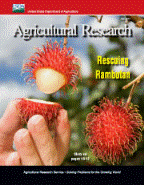United States Department of Agriculture: Agricultural Research Service, Lincoln, Nebraska

Agricultural Research Magazine
Date of this Version
1-2013
Document Type
Article
Citation
Agricultural Research January 2013.
Abstract
Soil-dwelling bacteria that depend on wheat and barley roots for their “room and board” could soon make good on their debt. Researchers are investigating the microbes’ potential to biologically control root-rot fungi that cause crop yield losses of 10-30 percent annually in the U.S. Pacific Northwest and other parts of the world.
The bacteria are members of the genus Pseudomonas and include 11 strains that stymie the growth of Pythium and Rhizoctonia fungi, which are responsible for dampingoff and root-rot diseases of wheat and barley. The pathogens thrive in cool, moist soils and can reach especially high levels in crop fields where conservation tillage is practiced to save on fuel costs, avoid soil erosion, and attain other ecological and environmental benefits.
“They’re most problematic to seedlings of spring crops that are 4 to 6 weeks old,” notes Pat Okubara, a geneticist in the Agricultural Research Service’s Root Diseases and Biological Control Research Unit in Pullman, Washington. “Fungicides are not very effective, and there are no resistant wheat or barley varieties yet,” she adds. Rotating wheat with nonhost crops is difficult too, because of the fungi’s extensive plant-host range.
Over the past year, Okubara and university colleagues have evaluated the biocontrol potential of 26 Pseudomonas strains. From those, they chose 11 for further study based on 3 important characteristics: rapid colonization of and persistence on roots, high antifungal activity, and reduction of plant disease symptoms.
Included in
Agriculture Commons, Animal Sciences Commons, Food Science Commons, Plant Sciences Commons

